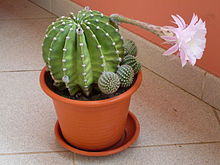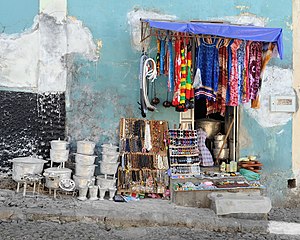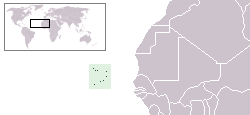Cape Verde (Portuguese: Cabo Verde, Kriolu: Kabu Verdi) is a country in West Africa. It comprises a group of islands of the Atlantic Ocean, west of Senegal. It is part of the region of islands collectively known as Macaronesia. In October 2013, the government declared that its official name would not be translated into foreign languages and the country is now the Republic of Cabo Verde or simply Cabo Verde in English, although it will probably take many years for this change to enter common usage.
Regions
Cape Verde is formed by 10 main islands and about 8 islets. The main islands are (clockwise from northwest):

| Santo Antão Great hiking. |
| São Vicente With the cultural capital of Mindelo. |
| Santa Luzia Santa Luzia is uninhabited but can be visited as a day trip from São Vicente. |
| São Nicolau |
| Sal Has great beaches, water sports and resorts aplenty. But little else. |
| Boa Vista Even nicer beaches. |
| Maio |
| Santiago Island The first island settled in Cape Verde. It holds the current capital Praia, the original capital Cidade Velha, and the bulk of the nation's population. |
| Fogo A spectacular volcano island which erupted as recently as 2014. |
| Brava A small island only accessible by boat and is a great place to get away from it all. |



Cities
There are 24 cities in Cape Verde.
- Praia – the capital, on Santiago Island
- Mindelo – port city on São Vicente, probably the country's liveliest
- Cidade Velha (Ribeira Grande) – A historic town on Santiago
- Espargos is the capital of Sal where the airport is and Santa Maria is the main tourist area at the south of the island
- Assomada is the seat of municipality of Santa Catarina on Santiago
- Santa Maria - former administrative capital and the most populous city on Sal
- São Filipe capital of island Fogo
Other destinations
- Brava, the smallest island, is a botanist's paradise, home to many unique flora that live in its misty forests
- Pico de Fogo - an active volcano on Fogo that has created a unique landscape best explored on foot or horseback
Understand
Cape Verde (pop. 506,000) is located 500 km from the west coast of Africa. The once uninhabited islands were discovered and colonized by the Portuguese in the 15th century; they subsequently became a trading center for African slaves and later an important coaling and re-supply stop for whaling and transatlantic shipping. Independence was achieved in 1975.
Most Cape Verdeans have both African and Portuguese antecedents.
Climate
Cape Verde’s climate is temperate, with a warm, dry summer. Precipitation is meagre and falls between the months of June to February, peaking in September.
Some islands see almost no rain: these are Sal, Boavista and Maio. The islands with most rainfall are Santiago, Fogo and Santo Antao.
Holidays
The national holiday is 5 July, Independence Day.
Get in
Entry requirements
Citizens of Angola, Benin, Burkina Faso, Côte d'Ivoire, Gambia, Ghana, Guinea-Bissau, Guinea, Hong Kong, Liberia, Macau, Mali, Mauritania, Niger, Nigeria, Senegal, Sierra Leone, Singapore and Togo do not require a visa to enter Cape Verde. Everybody else may obtain a visa on arrival at a cost of 40 euros.
By plane
Cape Verde has international airports on the islands of Sal, Santiago, Boa Vista and São Vicente. Connections to Europe, Africa, and the Americas.
Not all the connections are visible to travel booking websites, it is usually worth checking with a travel agent.
From Europe
There are regular flights from Amsterdam, Lisbon (daily), Madrid, Milan, Munich, and Oporto operated by TACV.
TAP Portugal fly from Lisbon.
Jetairfly has cheap flight from Brussels to Sal and Boa Vista.
You can fly direct to Santa Maria on Sal from London Gatwick, Glasgow and Manchester on Astraeus and also with Thomson Holidays from Birmingham, Manchester and Gatwick.
From the Americas
There are regular flights from Boston (weekly), Fortaleza (Brazil) (weekly).
From Africa
West Africa is also serviced by the oldest functioning and leading regional airline TACV Cabo Verde Airlines.
By boat
There are only infrequent, expensive connections to the mainland.
Get around
Timetables in Cape Verde are not to be taken too seriously - don't be too surprised if that boat departs ahead of schedule or if that flight suddenly gets postponed until tomorrow. This is important to consider if you decide to do some island-hopping. Due to weather and other conditions flights may be delayed or canceled. Carry your toothbrush with you and build in some buffer time to your planning especially if you need to meet an international connection.
By plane
TACV Cabo Verde [1] airlines has regular flights between the majority of the islands.
If you can afford to wait until you arrive, domestic tickets are cheaper if purchased in Cape Verde.
If your international flights are booked with TACV, you can purchase a Cabo Verde Air Pass for flights within 21 day period. Price start at €110 for two coupons and €60 for every extra coupon.
TACV flights can be rebooked for 2,000$.
Halcyonair [2] have also started servicing some of the major internal routes.
- TACV Cabo Verde Islands [3]
- TACV Air Pass [4]
- TACV (German Site) [5]
- Halcyonair [6]
- Cabo Verde Express [7]
By boat
There are ferry services between the islands. Depending on the distance between the islands you are going from and to, flying can be significantly shorter but also significantly more expensive.
By taxi
Nice, new taxis are available in the major cities and are not metered. Aluguers, which are usually either open back pickup trucks with bench seats or 15 passenger Toyota vans, tend to travel between more rural destinations, particularly on Santo Antão.
Talk
The official language is Portuguese, used in all official publications and announcements as well as in business, media and schools, but the local language is Cape Verdean Creole (Kriolu kabuverdianu), a Portuguese-based creole language with 90-95% of the words from Portuguese and the rest mainly from West African languages. It is divided into 9 dialects spoken on various parts of the country. Even though Kriolu is comprehensible to a skilled Portuguese-speaker almost all people can also speak Portuguese as a second language. French Creole is not the same as Cape Verdian creole, and a considerable number also speak English; basically, Kriolu is your first option, Portuguese second, English third.
It is a good idea to know some Kriolu or at least Portuguese, since even though young urban people are often quite proficient in English, this does not apply to old and rural people, and even those who can speak English will highly appreciate any attempt you do to speak Kriolu or Portuguese.
See

- Cidade Velha, whose name translates to "Old City" was the first European city in the tropics and an UNESCO World Heritage Site.
- The Cova valley on Santo Antão - located in a crater of an extinct volcano.
- The town hall, cathedral and Palace of Justice in the capital Praia.
- Fogo, an island of volcanoes, one of which erupted in 1995.
Do
- Game fishing
- Kite surfing & wind surfing
- Diving
- Jetskiing and other water sports
- Canyoning in Santo Antao
Buy

Currency
The official currency of Cape Verde is the escudo, abbreviated CVE and indicated with a cifrão (a symbol similar to the dollar sign, but with two vertical strokes instead of one) after the amount. The currency is fixed against the euro at 110$ per euro.
In the resort islands of Sal and Boa Vista, euros are commonly accepted, although you might receive change in escudos.
Money can be changed from all major currencies at the international airports at Sal and Praia. Bank branches at larger towns will also change money. Larger towns also have ATMs that will take Visa, MasterCard and Maestro.
High end hotels will accept credit cards. Other hotels will expect cash although many mid-range ones will accept euros at a reasonably exchange rate (slightly worse than the banks). For everything else, expect to pay in escudos.
Costs
Since most goods are imported, the cost of living is moderate to high. On the island resorts of Boa Vista and Sal, the cost of living oftentimes can be compared to their Caribbean counterparts. The island of Santiago is reasonably the least expensive.
Eat
Cape Verde has fantastic fresh seafood. Tuna is common, as is Wahoo - a white fleshed fish with similar texture.
- Lagostada – a lobster dish
- Cachupa - the national dish made with maize and potato. Fish or chicken commonly added for flavor.
- Tosta mista - common toasted ham and cheese sandwich.
European food is common on all the islands. Italian is especially popular on Sal. Vegetarians can ask for omelets or salads.
Drink
Local beer is a lager to drink ice cold, its name is STRELA, but you can easily find international beers and other drinks, including some from Portugal.
Sleep
There are plenty of hotels and guest houses throughout the archipelago. Though the largest hotels are based on the islands of Sal (Riu Funana and Garopa hotels--1000 rooms combined), and Boa Vista (Riu Touareg--881 rooms).
Learn
There are 10 universities including institutes in the country. The largest universities are: Jean Piaget University of Cape Verde and University of Cape Verde.
Work
The Cape Verdean economy is largely service-based, i.e., most Cape Verdeans work in industries, hospitals, transportation and tourism related activities.
Stay safe
Crime rates are relatively low. The emergency number is 132.
Stay healthy
In the resorts, the tap water is usually desalinated and safe to drink. In other areas, bottled water is cheap and commonly available.
Respect
People are polite and friendly: they will try to sell you something and if you refuse, they will invent stories about the hardship of their families. It is good to buy something, but important to bargain.
Connect
The telephone system is effective and improving. There is mobile phone coverage in all cities and most towns. Check with your provider as to the roaming costs.
The country also has one Internet service provider.

